Quick summary of multiverse ideas
COMING SOON!

Quick summary of multiverse ideas
COMING SOON!
The discoveries made by geologists and paleontologists about earth’s history make one of the most interesting and illuminating stories ever. That is why so many folk traditions have imagined their own versions of the story in the days before the empirical sciences. Even though the details of some of the mechanisms behind the dynamics of earth science are not yet completely understood, the knowledge gained explains very satisfyingly – and in great detail – how and why the earth and its inhabitants, including humans, have come to be what they are today. It also gives hints as to what may happen tomorrow. So read on.
There is still discussion as to the standard to be used for “million years ago”: “Mya” or “MA”. We will use the more intuitive Mya = million years ago, Gya = billion (thousand million, or giga) years ago. “My” then defines a duration of a million years.
First, let us look at the composition of the Earth.
Almost all rocks are made up of minerals, which are naturally occurring, inorganic, crystalline solids. Geologists distinguish them by their color, luster (how they reflect light), transparency (compare diamond and coal), streak (powdered form), hardness, tenacity, and cleavage and fracture (how they chip or break).
The mass of the Earth is constituted of the following proportions of elements by mass1Marshak, 142.:
The most common elements in rocks at the Earth’s surface are silicon and oxygen. These form silicate, a mineral having a tetrahedral structure rather like that of methane, as we saw in the carbon chapter. This image shows two of them bound together by sharing an oxygen between two tetrahedra.

Silicate double tetrahedra, by Ben Mills via Wikimedia Commons
This silicate binding can be extended to give the many different crystalline structures, such as rings and chains, which make up the rocks around us. For instance, quartz crystals have the following structure.
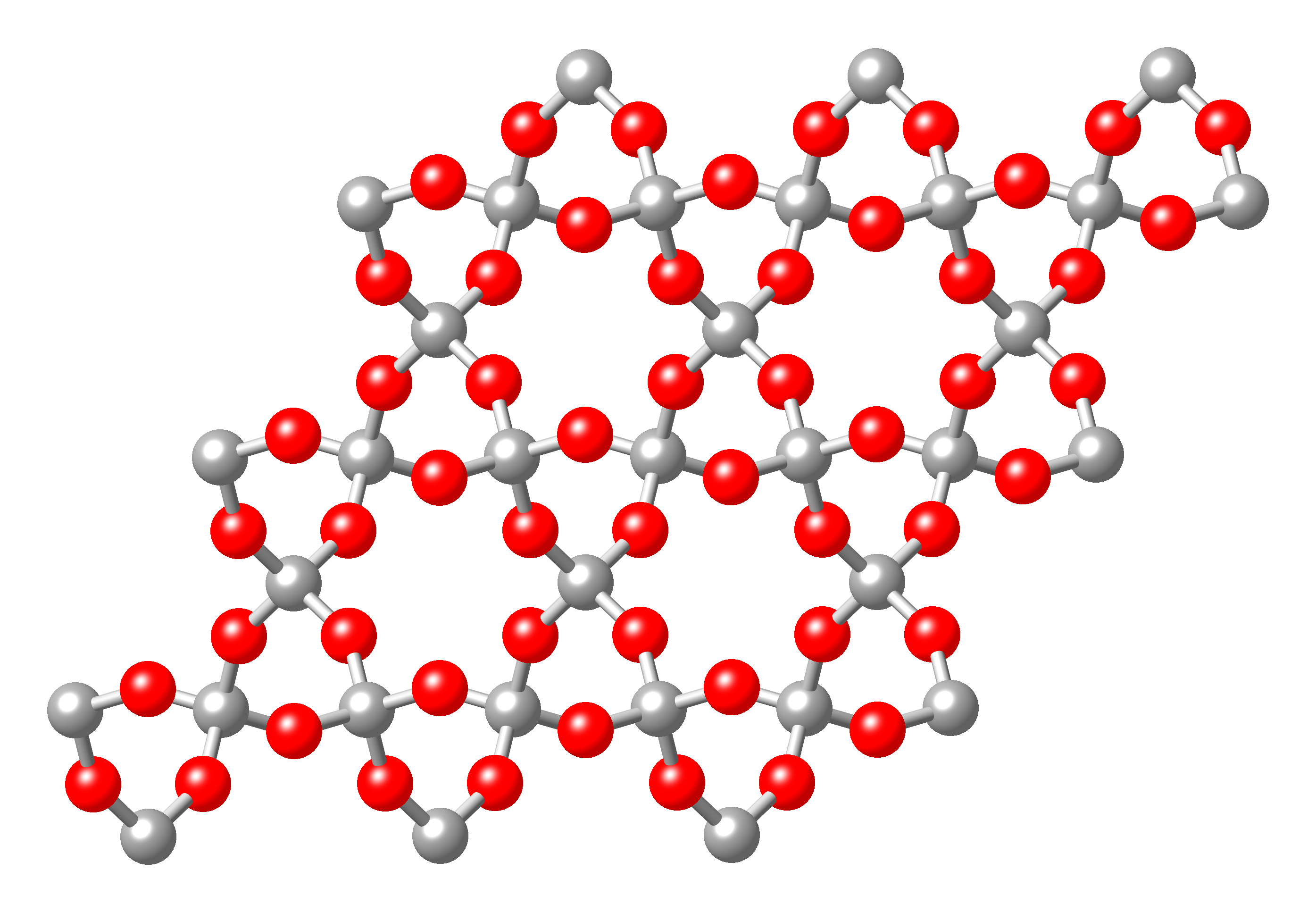
Ball-and-stick model of part of the crystal structure β-quartz, a form of silicon dioxide, SiO2, by Ben Mills via Wikimedia Commons
Beryl has a ring structure, shown here both as atoms and in a tetrahedron representation.
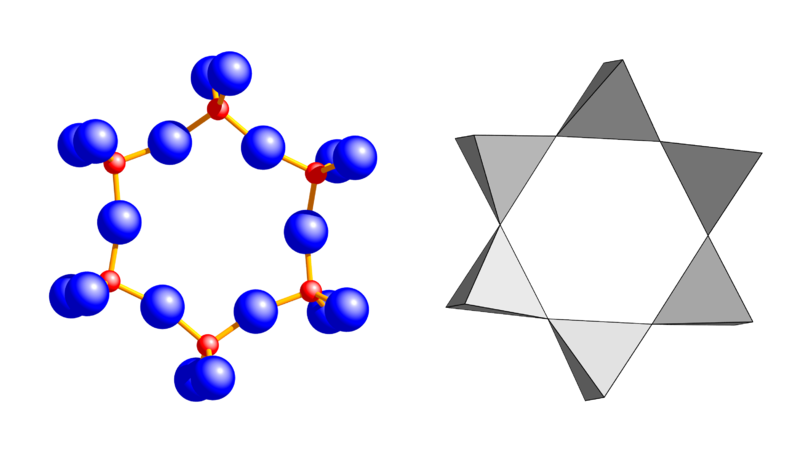
Unbranched 6er single ring of beryl from Brown and Mills via Wikimedia Commons
Non-silicate minerals (e.g., carbonates, sulfates and sulfides, oxides, etc.) make up only 5-8% of the Earth’s crust.
As is well known, there are three types of rocks:
Rocks may be intrusive (formed beneath the surface of the Earth) or extrusive (formed above the surface). Among igneous rocks, there are several types based on the amount of silica in them:
Some common examples:
Rocks and minerals are formed in a series of cycles. Volcanic activity causes hot magma to pierce the Earth’s surface, where it cools and hardens into various sorts of igneous rocks. Other material may be coughed up from below ground at the same time as igneous or metamorphic rock. As these rocks are weathered by ice, water and wind, they are broken down into smaller grains which are then carried to the sea or lake floors, where they accumulate, eventually to form sedimentary rocks. These rocks may then be pushed by subduction down to a hotter, denser level where they are converted into igneous or metamorphic rocks and the cycle continues again2This is only one of the cycles of nature. It may be compared to, e.g., the water cycle (clouds – rain – bodies of water – evaporation – clouds) or the nitrogen cycle (fixation – assimilation – nitrification – denitrification).. Such cycles have been active for 4 billion years.
The Earth consists of several layers. From the center:
1. The core, around 2500 km in radius, is composed of heavy metals such as iron and nickel and has two layers:
2. The layer outside the core is called the mantle and constitutes about 2/3 of the Earth’s mass. It is around 2800 km in radius and is composed mostly of light elements. Seismic studies show the boundary between core and mantle to be anything but smooth. The mantle has three layers:
3. Outside the so-called Moho discontinuity in the lithosphere lies the Earth’s crust, attached to the outer mantle. Above the Moho, the rocks are lighter and felsic, constituted primarily of silica, the principal constituent of surface rocks. There two kinds of crust:

Earth’s core , from “This dynamic Earth” via USGS. Distances are depths, measured from the surface.
The relative densities of the two crust types are important in plate tectonics.
Because of its iron core, the Earth is like a bar magnet and has a dipole magnetic field with north and south poles. This is thought to be due to a dynamo effect, wherein charged particles in the hot core move about due to convection or the Earth’s rotation.
Actually, the polarity changes randomly in geologic time; the poles actually reverse. If this were to happen today, Antarctica would be found in the south! Fortunately for human navigation, this does not happen frequently, the last time having been about 780 thousand years ago. Geologists find a record of this reversing polarity in the phenomenon known as magnetic striping – variations in direction of the magnetic field of the rock on the ocean floor.
As it “burns”, the sun continually spews out charged particles, mostly electrons and protons, creating a solar wind. Fortunately for us, the magnetic field due to the Earth’s metal core deflects these particles so that most of them pass around the Earth without doing any harm. Otherwise, they could actually blow away the Earth’s atmosphere. Mars is much smaller than Earth and has lost its original molten core and magnetic field, so the solar wind has stripped away its atmosphere, leaving the red desert that space probes are exploring today.
As the solar wind passes over the Earth’s poles, where the magnetic field is most intense, they sometimes ionize the air and produce the beautiful wavy colors of the aurora.
The Earth’s magnetic field can deflect only a limited amount of the solar wind. In 1859, an enormous solar storm called the Carrington storm released so much electromagnetic energy and solar matter that aurora were seen as close to the Equator as the Caribbean and Santiago, Chile. Telegraph communication was often interrupted and operators reported sparks jumping from their equipment. If it happened again now, things like GPS satellites and telecommunications equipment could suffer.
Plate tectonics (from the Greek tecton, builder or carpenter) is the theory which explains how plates of continental crust move about on the surface of the Earth. It answers the question of how and why they move. It explains the existence of volcanoes and mountains and furnishes the background for all Earth science. It has been said to be the theory of “how the Earth works”. It has transformed and integrated modern geology just as quantum mechanics and relativity have modern physics or evolution, biology.
The idea of plates, continent-sized hunks of lithosphere moving on the surface of the earth, was first suggested by the comparison of the eastern border of South America with the western border of Africa. Since then, understanding of the Earth’s interior has explained how this works, although some details of the driving mechanism (especially, mantle plumes and hot spots) are still subjects of discussion .
The Earth’s lithosphere is composed of plates, seven main plates and numerous smaller ones. The plates are essentially huge hunks of rock centered around very ancient cores called cratons, most of which were formed during the Precambrian eons, perhaps as early as 4.3 Gya. They were certainly in existence by around 3.8 Gya, according to the age of sediments in western Greenland. Recent studies suggest that plate tectonics began about 3 Gya.3“New study zeros in on plate tectonics’ start date’, http://cmns.umd.edu/news-events/features/3404. The oceanic plates are thinner (less than 15km), but are composed mostly of very heavy basalt. The continental plates are thicker (up to 200km) but are composed mainly of granitic rocks, which are lighter. The plates essentially float on the asthenosphere, the next layer down, which is not a liquid, but can flow very slowly due to its high temperature.
It is currently thought that thermal convection due to the Earth’s hot core causes the plates to move very slowly about. This movement has caused the configuration of land – the continents – to change over geological history.

The Earth’s tectonic plates, from “This dynamic Earth” at USGS
When a plate of dense, oceanic rock collides edge-on with a plate of less dense continental rock, it is pushed down under the edge of the continental plate in a process called subduction. The descending ocean plate may create a deep trench at the boundary. Because of the heat from the rocks’ rubbing together and because water vapor released by the oceanic crust lowers the melting point of the rocks in contact with it, much of the rock melts, creating magma. Some of this rises through faults in the crust and a line of volcanoes may be formed along the edge of the continental plate above the subduction zone. The western coast of South America and much of that of North America are regions where the Pacific plate is being subducted under the American plates, forming the Andes and other mountains.
The Indian plate, which was once a separate continent south of Asia, moved northward and swung around to plow slowly into the southern edge of the Eurasian plate about 55 Mya. The impact between the two equally dense continental plates brought about no subduction, but instead pushed up the string of mountains known as the Himalayas. The process has not ended and the Himalayas are still growing.
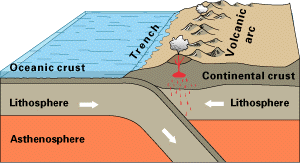
Subduction, from “This dynamic Earth” at USGS
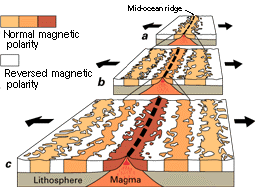
Ocean-floor magnetic striping, from “This dynamic Earth” at USGS
Volcanic processes deep in the Earth below the ocean beds can break through the thinner oceanic crust, letting magma escape. This magma usually forms basalt on cooling, so the Earth’s ocean floors are paved with dense basalt.
Right down the middle of the Atlantic Ocean, there is a ridge formed by magma pushed up by volcanic processes. As the magma flows out in east and west directions, perpendicularly to the ridge, the plates on either side grow at a rate of about 2.5 cm per year, so that their outer parts are pushed further east and west. In this way, the plates on either side of the Atlantic grow outwards from the mid-ocean ridge. In plate tectonics, this movement of two plates away from each other is called a divergent boundary or rift.4There is still some disagreement as to whether the rifting is pushing the plates apart or whether the moving plates are pulling away at the rift.
Not all magma moves to the side immediately. It tends to pile up, so that the central line of activity is higher than the surrounding area, forming an underwater mountain chain, such as the one down the center of the Atlantic. Running along the middle of the sub-oceanic chain, there is a trench where the magma comes out.
All the world’s oceans have come about in such a rifting process. In the case of the Atlantic Ocean, the oceanic and continental crusts on each side form single lithographic plates, so the above-water parts of the continental plates of the Americas and of Africa and Eurasia seem to move apart.5The mechanism explaining this phenomenon is still a subject of discussion. Since the surface area of the Earth remains the same, plates which are added to in one place must be destroyed elsewhere. As the Atlantic gets wider, so must the Pacific get smaller. This explains the widening or disappearance of oceans.
Magma also may break through the ocean floor at a single spot, know as a hot spot, bringing about the formation of a volcanic island above it. As the oceanic plate slides across the hot spot, a series of volcanoes may be formed, as is the case for the Hawaiian Islands or Icelandic volcanoes.
Molten magnetic rock solidifies in such a way that magnetic dipoles in it conserve the orientation of the Earth’s magnetic field. When the field reverses direction, so does the magnetization recorded in the rocks. The symmetric distribution about the trench of the magnetized rocks points clearly to spreading of the sea floor.
Plates may converge on each other, as in subduction along the Pacific shore of South America, or diverge from each other, as is probably happening in the Great African Rift, or slide alongside each other, as in the San Andreas Fault in California. Sometimes, two zones of continental crust may converge, piling up mighty mountain chains, as has been the case with the Pyrenees, the Alps or the Appalachians and is still going on in the Himalayas.
Iceland is a fascinating geological showplace where the mid-ocean mountain range has been pushed up above the water level by a local hot spot. Over time, the country has moved relative to the hot spot, leaving volcanic craters along the path. The whole island country sits astride the rift between the North American and European plates.
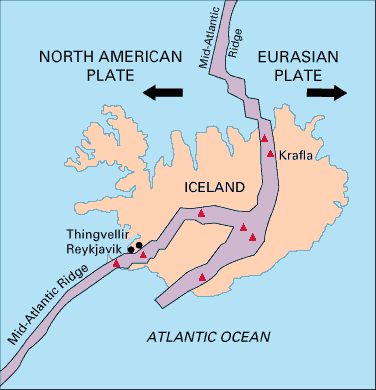
Iceland sits astride the joint of two plates, from “This dynamic Earth” at USGS

Looking out over the mid-Atlantic Ridge, the the rift between the American and European plates, at Þingvellir, Iceland. Photo by author.
Plate tectonics tells us that the continents we know have been in different configurations over the eons, sometimes separate, sometimes joined together into different large continents. At least once, they were joined together into a single supercontinent called Pangea, about which, more later.
In our solar system, plate tectonics is unique to Earth; no continental plates are known on other planets. Plate tectonics is of great importance for the evolution of living organisms.
Life on Earth depends on its atmosphere, a thin layer of gases, mostly nitrogen and oxygen, as well as some hydrogen and carbon and minute quantities of other elements. The atmosphere protects us and provides an environment suitable for life. It in turn depends on several other factors: the Earth’s temperature, its size (and, therefore, gravity) and its distance from the sun. In fact, in the beginning of Earth’s existence, the sun was not so bright, so temperatures were lower than one might expect..
The atmosphere is important not only for its breathable gases but also for the protection it affords. It is essential in acting as a greenhouse gas to conserve the warmth from the sun. This effect can be overdone, as has been the case on Venus, which is much too hot to sustain life. The atmosphere also protects us from dangerous ultraviolet rays. And it shields us from countless meteorites, which are burned up from friction in the atmosphere before they can strike the ground and make huge craters, as has occurred on the atmosphere-less planet Mercury or on the Moon.
The atmosphere is held onto the Earth by the gravitational force of the Earth itself. Earth’s mass and therefore its gravity is just right to hold onto the heavier gases nitrogen and oxygen that we breathe. In contrast, Mercury’s gravity is too weak to hold on to much of anything, so it has lost all its atmosphere. Jupiter, which is much larger than Earth, retains light gases as well, but packs them all down into concentrations such that its atmosphere is enormously dense. Tremendous storms rage across its surface, the most obvious one being the famous Red Spot.
The Earth’s size and its distance from the sun are delicately balanced. If the Earth were closer to the sun and therefore hotter, or if it were smaller and had less gravity, the movement of the atmosphere’s molecules would be great enough to allow them to escape the Earth’s gravitational attraction. Similarly, the relation between the production of heat by Earth’s core and the size of the Earth is crucial to maintenance of a temperature conducive to life. The temperature of the Earth’s surface also depends on its distance from the sun (closer would mean hotter) and its rotation (toasting each side evenly). The planet Venus is much closer to the Sun and its surface is burned up.
The Earth’s temperature and gravity guarantee conditions necessary to the existence of water in three phases – gas, liquid and solid – which are the source of all Earth’s weather and the rain cycles which irrigate the land. On Titan, one of Jupiter’s moons, analogous conditions hold for different reasons, namely that its atmospheric molecules are much cooler than Earth’s, so its lesser gravity is adequate to retain them. But the greatly reduced temperature relative to Earth’s means that the phases there are of methane, not oxygen. All the water on Titan is frozen hard as steel.
All these things — the hot magnetic core, the atmosphere, the distance from the sun, the size and the orientation of the Earth — work together to make life possible on our planet. Without any one of them, things would be a lot different. The Earth – and we, ourselves – must be considered privileged to be in a set of conditions propitious for life.
This seems as good a place as any to discuss the carbon cycle.1 It is a good deal more complex than the water cycle already presented.
Two major atmospheric components contain carbon: carbon dioxide (CO2) and methane (CH4), both greenhouse gases, but methane being far more powerful,
Geologists consider that carbon is exchanged among several types of carbon reservoirs:
The carbon cycle consists of a number of processes occurring in these reservoirs and exchanging carbon among them. Several such processes take place on land:
Processes of the carbon cycle in the sea include the following:
In the atmosphere, CO2 content is in a “delicate balance” which can be influenced by external phenomena. For instance, an increase in seawater temperature causes more CO2 to be released into the atmosphere; decrease,d temperature enhances absorption.
Over the long term, volcanic activity adds CO2 to the atmosphere and the resulting greenhouse effect increases atmospheric temperature. CO2 dissolves in rainwater to make carbonic acid (H2CO3). The acid and the increase in temperatrue both cause increased chemical weathering of rocks. The rock particles are then laid down as sediment which may later be subducted and eventually be ejected by volcanoes. The cycle then repeats.
So a long-term equilibrium between volcanic activity and chemical weathering (and other factors) maintains a balance of atmospheric CO2 over time.
O course, human emissions (fossil-fuel burning, livestock, etc) release CO2 and other greenhouse gases into atmosphere, leading to rises in global temperatures.
Geological clues come from different sources.
Now on to the first eon, the Hadean.
Notes
| ↑1 | Marshak, 142. |
|---|---|
| ↑2 | This is only one of the cycles of nature. It may be compared to, e.g., the water cycle (clouds – rain – bodies of water – evaporation – clouds) or the nitrogen cycle (fixation – assimilation – nitrification – denitrification). |
| ↑3 | “New study zeros in on plate tectonics’ start date’, http://cmns.umd.edu/news-events/features/3404. |
| ↑4 | There is still some disagreement as to whether the rifting is pushing the plates apart or whether the moving plates are pulling away at the rift. |
| ↑5 | The mechanism explaining this phenomenon is still a subject of discussion. |
This is the history of the Earth, from about 4.5 billion years ago until now.
The first chapter chronicles the Earth’s hellish beginnings, the Hadean Eon, as well as geophysics, including plate tectonics.
The second chapter follows the rise of life up to the age of reptiles.
The third chapter starts with the age of reptiles, folows their demise and the rise of mammals and up to the present day.
Today, there are hundreds of billions of galaxies, each containing hundreds of billions of stars. And that is just for the observable universe.
Space is really, really big. Not only are stars grouped into galaxies, galaxies are grouped into clusters and clusters into superclusters. Stars in a cluster generally have about the same age and were probably formed from the same nebula. Our galaxy, the Milky Way, is a member of a group — too small to be called a cluster — called the Local Group.
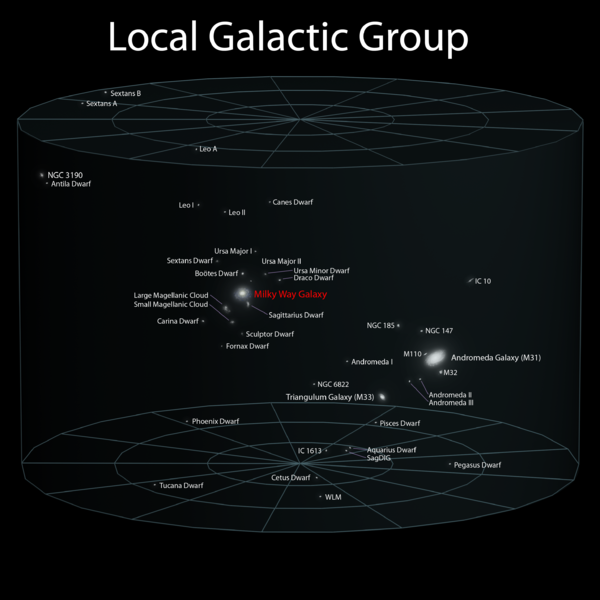
Local galactic group, by Andrew Z. Colvin via Wikimedia
Studies of the large-scale structure of the universe — on scales where galaxy clusters look tiny — indicate that galaxies are spread out in a filament-like structure. It is sometimes compared to soap bubbles, where the galaxies are distributed mainly on the surfaces of the bubbles.
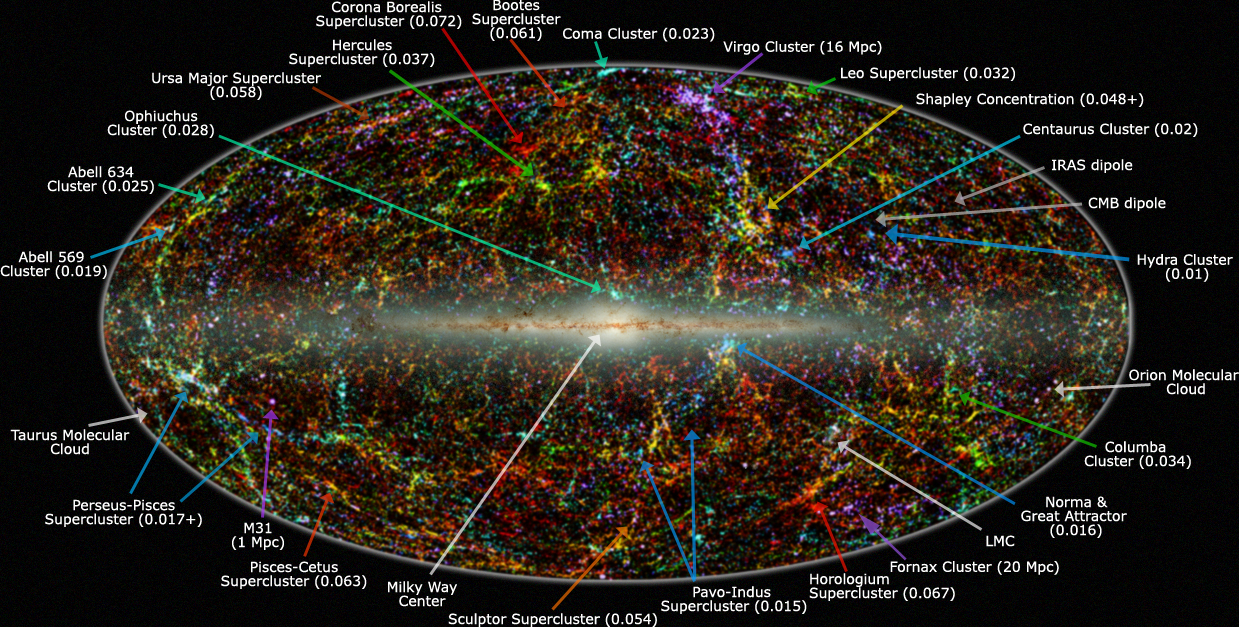
Panoramic view of the entire near-infrared sky reveals the distribution of galaxies beyond the Milky Way. by IPAC/Caltech via Wikimedia.
Although the interior of the “bubbles” is less bright, so that they are also called voids, there are galaxies inside them, including our Local Group.
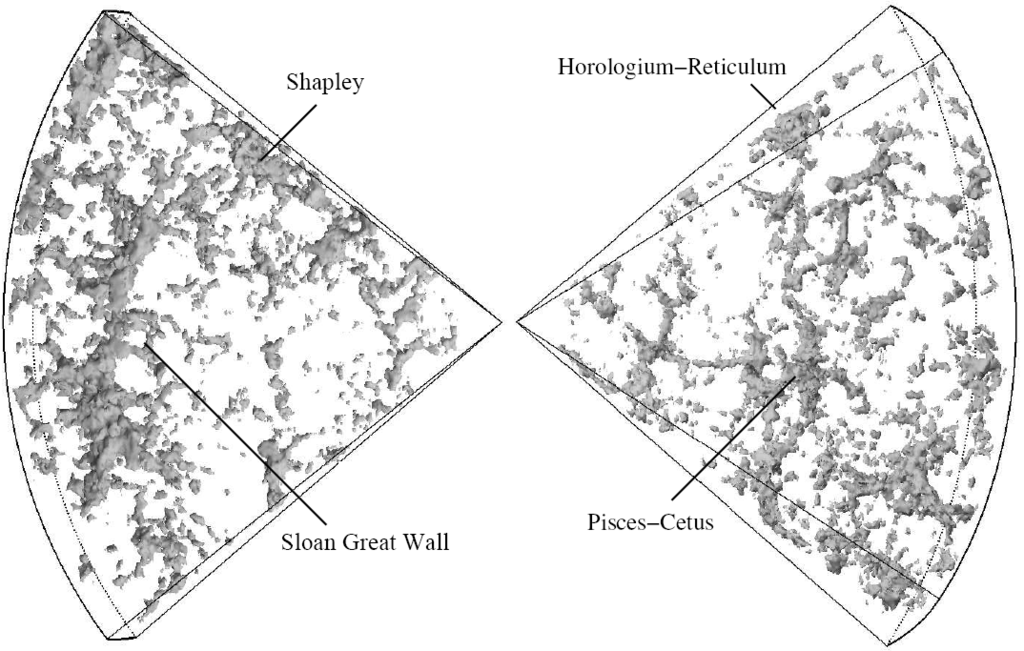
Reconstruction of inner parts of d2f survey by William Schaap via Wikimedia Commons
Assuming the validity of the Cosmological Principle, that the distribution of objects in the universe is homogeneous and isotropic (the same everywhere and in every direction), the equations of GR have different solutions for the geometry of the universe. These solutions correspond to three possible sorts of curvatures of the universe (in the GR sense).

Geometry of the universe, from WMAP via NASA
The geometry depends on a parameter called the critical density of the universe, ρcrit. One often refers to Ω0, the ratio of the observed density to the critical density, .
Ω0 = ρobs/ρcrit.
For Ω0 >= (greater than or equal to) 1, space is infinite. If space is infinite now, it always has been, including at the Big Bang. That was indeed the universe in a grain of sand!
It is now thought that the universe is composed of three sorts of matter and energy.
Ordinary matter is the classic one and once was thought to be the only kind. This is the matter we are familiar with and which is composed mainly of protons, neutrons and electrons. Contrary to previous ideas, we now know that it only makes up 4.6% of the energy density of the universe1All percentages in this section come from WMAP.. The rest is made up of dark matter and dark energy.
It has been observed that the outer parts of galaxies rotate too fast; the amount of matter in the galaxy is insufficient to generate a gravitational force capable of keeping them from spinning off into space. But dark matter could counteract that centrifugal force. The mass of dark matter provides the gravitational pull needed to hold the galaxy together. Similar phenomena are seen for galaxies in clusters and for the strength of gravitational lensing.2Bending of light waves from a distant star by another star or a planet, like by a lens.
Dark matter must be composed of something which interacts only weakly with ordinary matter and is not visible to us. Other than that, its composition is still unknown. It may be non-baryonic matter left over from the Big Bang. Hypothetical dark-matter particles are referred to as WIMPs, Weakly Interacting Massive Particles. Recent studies suggest several types of such particles.3Astronomers Measure the Density of Dark Matter in Galaxy Clusters. SciTechDaily. Dark matter constitutes 24% of the energy density of the universe.
Dark energy is stranger yet. It has been observed from SNIa red shifts that the expansion rate of the universe has been increasing over about the last 7 billion years. The equations of GR contain what at first seemed an arbitrary constant,4Deemed the Cosmological Constant. which has the interesting – in this case, very handy – property that it causes space to be suffused with a dark energy of negative pressure which exerts a push, not a pull, on matter. After inflation ended, ordinary gravity attracted matter together and slowed down the expansion. But expansion continued nonetheless. As matter became more diffuse in space, gravity was no longer a match for the dark-energy pressure, which is thought to be a property of space and so is constant and not diluted. Since about the time the universe celebrated its 7 billionth birthday, the dark-energy push has been stronger than the attraction of gravity and the expansion of the universe has accelerated. Dark energy has been calculated to furnish 71.4% of the energy density of the universe. Almost amazingly, this is just the total energy density required in order for Ω0 to be approximately equal to 15WMAP finds a value of 1.02+-0.02. so that the universe is “flat”.
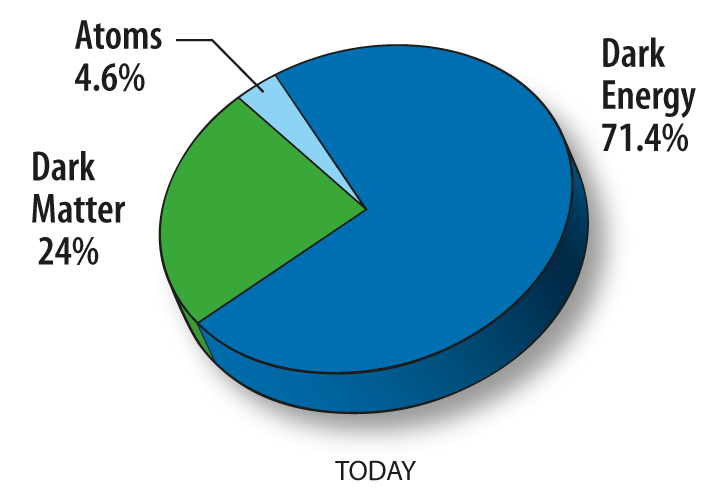
Universe makeup pie chart, from WMAP via NASA
The bad news is that theoretical calculations of the constant come up with a value far, far too large to be true. Work continues.
In summary, dark matters attracts and can be diluted by the expansion of space. Dark energy repulses and never dilutes.
It is quite astonishing that only of 4.6% of the
About 10 Gya, a new protostar formed in the outer fringe of the the galaxy we call the Milky Way. The agglomeration of dust was probably initiated by shock waves from a nearby exploding supernova. The protostar was turning, and since the centrifugal force was greatest in the plane perpendicular to the axis of rotation, matter surrounding the forming Sun was compressed into a flat disk of dust formed around the big lump in the middle. Increased density meant increased pressure and, therefore, temperature. The lump condensed further and became the proto-Sun. The matter in the disk also clumped together into rotating chunks. Some of these had diameters of 1 km or so and are called planetesimals. The passage from a cloud of dust and gas to a star surrounded by planetesimals probably only took about ten million years6McDougall (2011), 29..The largest of these chunks formed the planets; the other, smaller pieces, became asteroids and comets. Heavier elements like iron and silica were held by the Sun’s gravity and so formed the closer planetesimals which would become the four rocky planets – Mercury, Venus, Earth and Mars. Lighter gases like hydrogen and helium were volatilized by the heat and blown farther out by the solar wind and came to form the giant gas planets, Jupiter, Saturn, Uranus and Neptune. When the centrifugal force of their motion around the Sun balanced out gravity, they were maintained in elliptical orbits at nearly constant radial distances7Elliptical radii, major and minor, to be sure. from the Sun. Slowly, the protoplanets swept their orbits clean, merging the encountered rocks with each one’s surface. The subsequent history of the Earth is the subject of geology and so the next chapter.
According to currently prevailing cosmological theory, the ultimate state of the universe is quite literally not bright. There are minority opinions to the contrary.
As we have seen, in 5 billion or so years, the Sun will flare up into a red giant and engulf the Earth, including us, unless we can escape to another solar system, a voyage of at least several generations. But even that would be a temporary respite. Meanwhile, our solar system finally
On a broader scale, galaxies will disperse as stars explode into dust floating throughout expanding space-time. As the universe goes on expanding under the impulsion of Dark Energy, the dust eventually will be too diffuse for another star to form from it under the pull of gravity. The universe will then become a thin “soup” of particles diffused randomly throughout an enormous and ever-expanding void. The expansion of space will prevent any communication between celestial objects.8This does not violate Special Relativity. It is not a signal moving faster than light, it is space expanding. Besides, how does one define velocity in expanding space…? There will be only cold and darkness, with no starlight to warm and delight us and no “us” there to be warmed or delighted. It will be totally silent, not a bird will sing, nor a cat meow. “The Big Freeze”.9This will be the fate of the universe if it is indeed flat, as is now thought. If the energy density is greater than it is thought to be, then the universe may eventually collapse back onto itself in a “Big Crunch”. Feel better?
Nevertheless, the understanding of the universe around us underscores and nourishes our astonished appreciation of its beauty. The knowledge that time for life and beauty, although vast, is limited can remind us to appreciate that we are here now – once – so it is our only chance to make the best possible use of our limited lifetimes – individual or collective. Perhaps we even will manage develop ways of living which will leave the billions of years of life still left on Earth a place pleasing to our descendants – whatever they may be.
So much for cosmology. On to read about what geology tells us.
Notes
| ↑1 | All percentages in this section come from WMAP. |
|---|---|
| ↑2 | Bending of light waves from a distant star by another star or a planet, like by a lens. |
| ↑3 | Astronomers Measure the Density of Dark Matter in Galaxy Clusters. SciTechDaily. |
| ↑4 | Deemed the Cosmological Constant. |
| ↑5 | WMAP finds a value of 1.02+-0.02. |
| ↑6 | McDougall (2011), 29. |
| ↑7 | Elliptical radii, major and minor, to be sure. |
| ↑8 | This does not violate Special Relativity. It is not a signal moving faster than light, it is space expanding. Besides, how does one define velocity in expanding space…? |
| ↑9 | This will be the fate of the universe if it is indeed flat, as is now thought. If the energy density is greater than it is thought to be, then the universe may eventually collapse back onto itself in a “Big Crunch”. Feel better? |
Before about 200 My ABB.1After Big Bang, only simple atoms existed, mostly single protons (hydrogen) and a small number of proton-neutron pairs (helium).They formed clouds of particles which are referred to by the Latin word, nebulae. There are nebulae out there today, but their composition has changed since the first stars started to form. We will see how.
The life cycle of stars follows a series of steps.
After about 200 My, the universe had cooled enough that the gravitational force could finally come into play, so particles of matter were attracted to each other. Dust particles stuck together and formed tiny clumps which in turn adhered to orm larger ones. Thus, a larger clump of gaseous matter was built up. As its density increased, it became warmer. If the mass of such a clump exceeds the so-called Jeans mass2The Jeans mass depends on temperature and density, but is typically many thousands of solar masses., the matter composing it becomes so dense that any generated radiation (photons) cannot escape, so the clump becomes opaque. The trapped photons cause the clump to heat even faster. The clump had become a protostar.
So first, the strong force formed nuclei, after which the electromagnetic force formed atoms. Then the gravitational force formed clusters of matter which became stars, galaxies, planets and black holes.
The opposing forces of pressure and gravity have opposite thermodynamic effects. Gravity pulls matter into a more organized state, so one of lower entropy. However, the radiation from the outward pressure disperses more than enough energy into space to guarantee a global increase in entropy.
A protostar may or may not go on to become a star. If its mass is too low (<8% of the mass of our Sun), its temperature never becomes high enough for fusion to begin and the protostar becomes what astronomers call a brown dwarf.
In larger protostars, when the temperature rises to 107 Kelvin, a series of nuclear fusion reactions referred to as the proton-proton chain uses protons to produce helium. First, the protons fuse together to form deuterium (2H, with one proton and one neutron in its nucleus), then 3He (2 protons and one neutron) and finally 4He (2 protons and two neutrons).3A word on notation. A superscript before an element’s symbol denotes its atomic mass, essentially the total number of neutrons plus protons in the nucleus. When fusion starts to take place, the protostar has becomes a star. This first occurred only when the universe was some 200 million years or more old.
The fusion process is often referred to as “burning” of hydrogen, but it has nothing to do with ordinary terrestrial burning, or oxidation. It is really 4 protons forming 2 protons and 2 neutrons held together to form a helium nucleus. Since the nucleus weighs somewhat less than the initial 4 protons, the extra mass is converted into a great deal of energy4If only we could harness this fusion energy here on Earth! due to the large size of the speed of light, c, in the famous equation from GR,
E = mc2.
Some of this energy is emitted in the form of light emitted by the the stars, so from the moment fusion began, the universe was not only transparent, there was light (i.e., photons) in it.
Astronomers visualize the formation and subsequent life of stars by a two-dimensional plot called the Hertzsprung-Russell diagram (hereafter abbreviated HR). The HR is somewhat analogous to the Periodic Table of the elements in that it arranges stars by their properties in such a way as to show similarities between them. It is a scatter plot (points in a 2-dimensional space) of luminosity (or brightness, on the Y-axis) versus temperature (or spectral class, on the X-axis). Stars close to one another on the diagram are found to share many properties. As stars evolve, they move from one point to another on the diagram, unlike elements, which maintain their place in the periodic table. About 90% of stars fall on the diagonal – called the main sequence – between hot, luminous stars in the upper-left-hand corner and cool, dim ones in the lower-right-hand corner. Our Sun lies near the center of the main sequence – for the moment (where the “moment” will last about another 5 Gy). A star’s position in the main sequence is mainly a function of its mass. The current state of the Sun is taken as the standard luminosity.
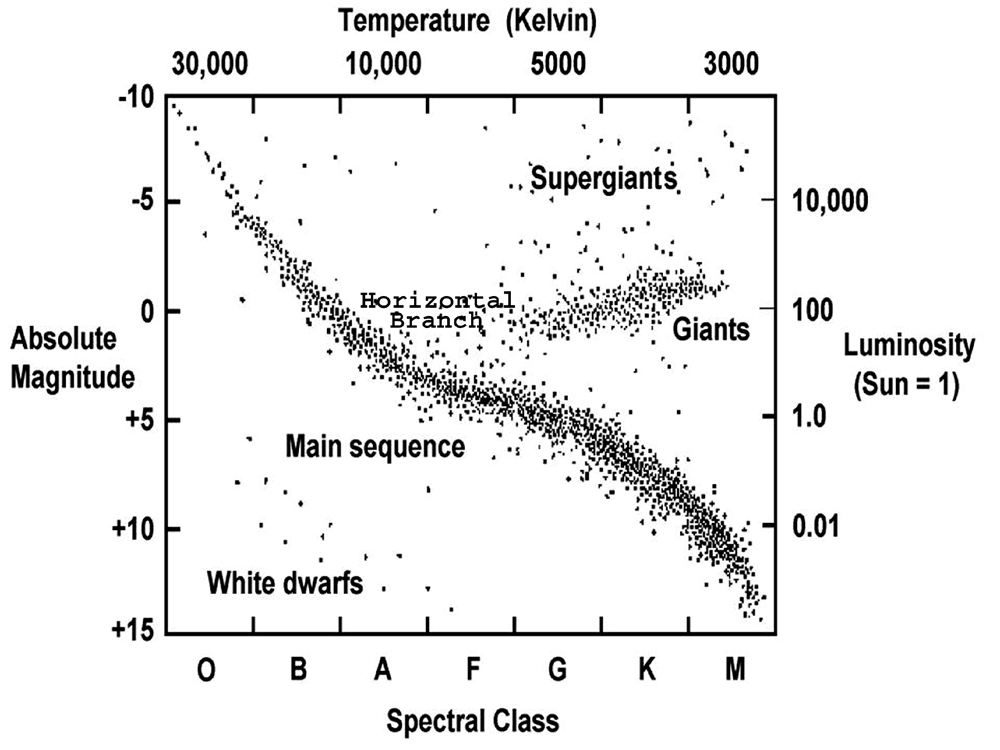
Hertzsprung-Russell Diagram, Chandra X-ray Observatory via NASA
A star is maintained by the so-called hydrostatic equilibrium between the outwardly-directed pressure due to the fusion in the core and the inwardly-directed force of gravity due to the star’s mass. Larger stars burn faster and so have briefer lives than smaller stars. But in all stars, the hydrogen fuel in the core is eventually depleted. The pressure then is reduced to where it can no longer counteract the force of gravity and the core contracts. As it does so, it heats up and generates increasing outward pressure. If the star is very small, it just radiates the energy away. But for most stars, there is still some hydrogen in a thin layer on the outside of the core and the core-generated heat causes it to begin to fuse into helium in hydrogen shell fusion, as opposed to the hydrogen core fusion which has taken place until now. Observation of the envelope, which is all we can see, will first show a slight cooling with only a small increase in brightness, but then the increased pressure from the core will bring about an increase in size of a hundredfold or more at approximately constant temperature. This is shown on the HR diagram below. The star’s color will change to orange and it will become a red giant. When the Sun reaches this stage, it will probably engulf the inner four planets – among them, Earth.
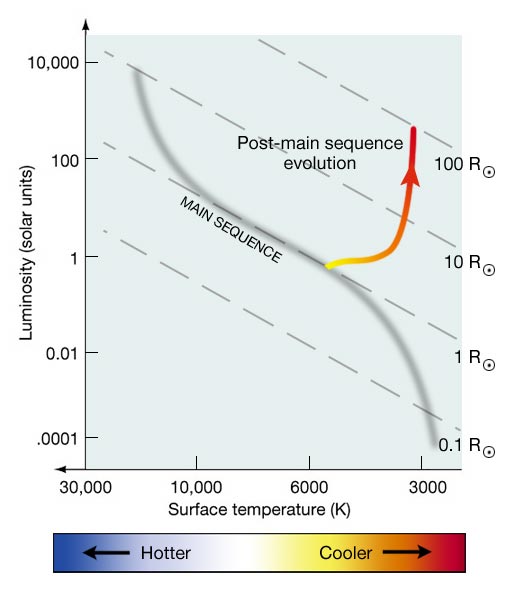
Evolutionary track for a Sun-like star to the red giant phase, Creative Commons image from Pennsylvania State University
After the red-giant phase, what happens depends on the mass of the star. We will mention a few possibilities. For the moment, let us go on considering a star the size of the Sun.
The star’s core still is not in equilibrium and continues to contract until it hits the limit imposed by the QM exclusion principle, which keeps its electrons from occupying the same QM state. Within the core, the helium resulting from the preceding hydrogen core fusion begins to fuse into heavier elements,8Be, 12C (and 16O, in still heavier stars). Since 12C formation requires three alpha particles (4He nuclei), the process is called the triple-alpha process and the star is in the core helium fusion phase. The star now has two layers, the inner one fusing to heavier elements than the outer one.
For the Sun, this stage will last less than about 1 billion years, during which it will “burn” 4He into 12C and 16O. A star of about this size will live for a total of around 10 Gy5Most authors would say 10 billion years, but in order to be consistent with later chapters, we will say 10 Gy. Since the Sun has already lived for almost 5 Gy (as we shall see in the geology chapter), it has (and we have) about 5 Gy left.
The core helium is used up faster than its hydrogen was and when this occurs, the core contracts again. The increased temperature causes a thin shell of remaining helium just inside the hyrdogen-fusion shell to go on fusing. The core now has three layers: an inner layer of carbon and oxygen, a middle layer of helium fusion and an outer shell of hydrogen fusion. The star expands again and becomes a red supergiant.
After this, the loss of mass to solar wind and the reduced supply of nuclear fuel will lower the star’s pressure to where gravity shrinks it to approximately the size of the Earth. Its outer layers will be cast outwards into an expanding shell of gas and for a while it will be a hot core of carbon surrounded by a planetary nebula (cloud) of ionized gas.6Note that a planetary nebula has nothing to do with planets. UV radiation from the cooling core lights up the gaseous nebula.

The Ring nebula, M57, NGC 6720, from NASA
After the dust drifts away, all that will be left of the Sun’s core will be a relatively cool and invisible white dwarf. The star is supported against collapse only by the QM exclusion principle. Eventually, the white dwarf will cool into a hunk of cold iron – an unglamorous end to quite a stellar career. This will be the fate of any star less than about 1.4 times the mass of the Sun, a figure known as the Chandrasekhar limit.
Within the matter ejected into space as nebula, the whole process can start over again with agglomeration of dust to form protostars, but with two important differences.
The main-sequence expansion to a red giant does not necessarily go smoothly. Some stars will be in unstable equilibrium, like a wobbly tight-wire walker. Pressure may cause them to overshoot and become too big, then gravity will take over and they may become too small. And so on, back and forth. Such stars are called either Cephiad variables or RR Lyrai variables.
For stars distinctly more massive than the Sun, the sequence may go further. In a later stage, 12C and 16O may fuse to 20Ne, 23Na, 24Mg and 28Si. In turn, 28Si may fuse to 56Fe, but this can only take place in the most massive stars. In any case, that is where the process stops; Fe does not fuse to anything else. This is the second step of nucleosynthesis.
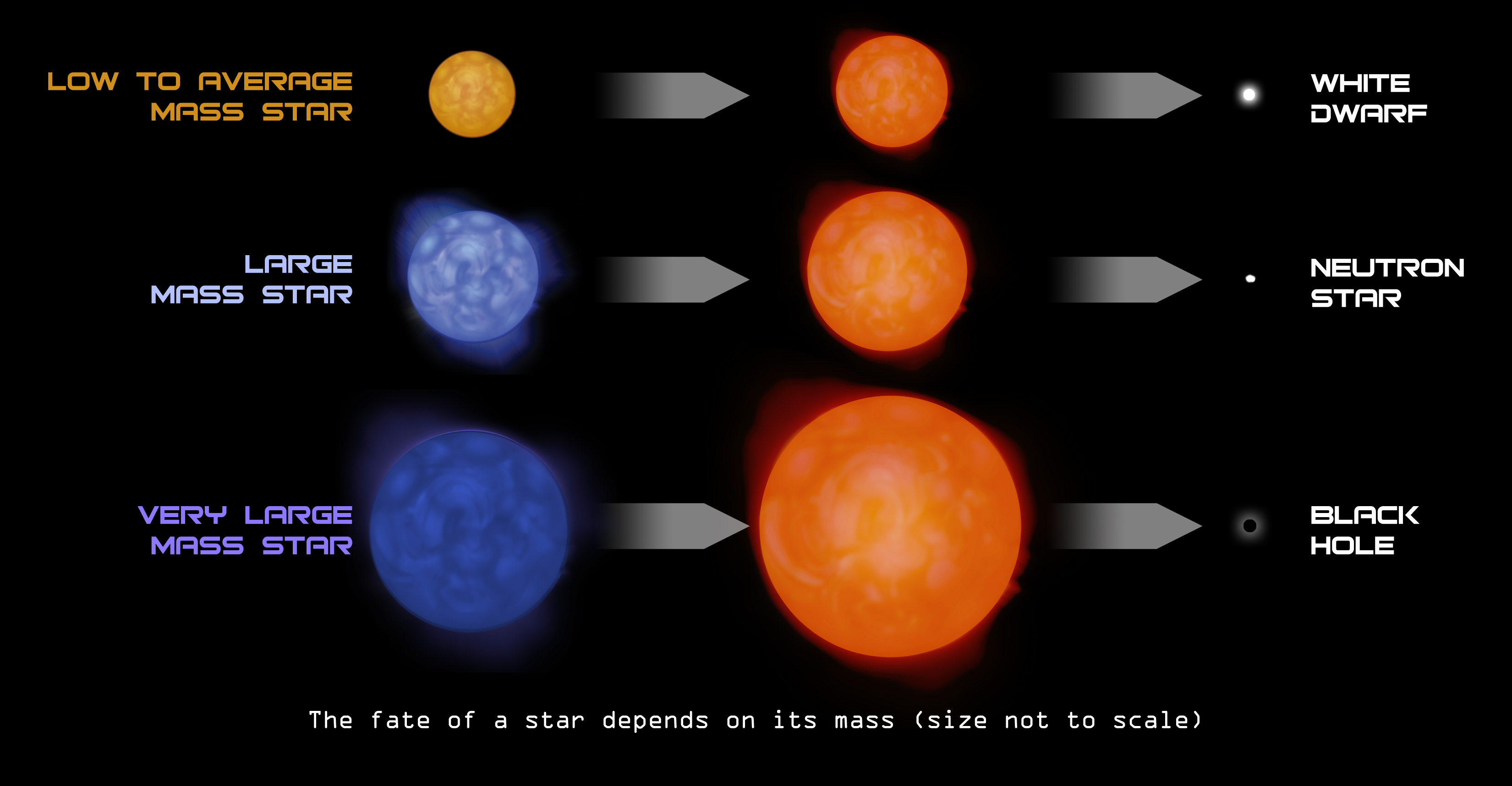
The fate of a star depends on its mass, from Chandra X-ray Observatory, via NASA/CXC/SAO.
As massive stars pass from step to step of the fusion process, burning successively carbon and oxygen, then other elements, each step takes place in the core’s center, pushing the previous step’s reactants outwards. So the star comes to have a number of layers, like an onion, with different fusion reactions taking place in different layers. Each successive step takes less time, the fusion of Si into Fe taking only on the order of four days. Once the Si is converted to Fe, though, the pressure drops and nothing can keep the star from collapsing. The outer layers “drop” towards the center and bounce off the core, causing the whole structure to explode and become a Type II supernova (SNII). Such an enormous amount of energy is released that the light is as bright as that as of several billion Suns. For some days or weeks, it may be the brightest object in the sky, depending on how far away it is. Light from the supernova gets brighter over a period of about 20 days and then decreases slowly over a year or so.
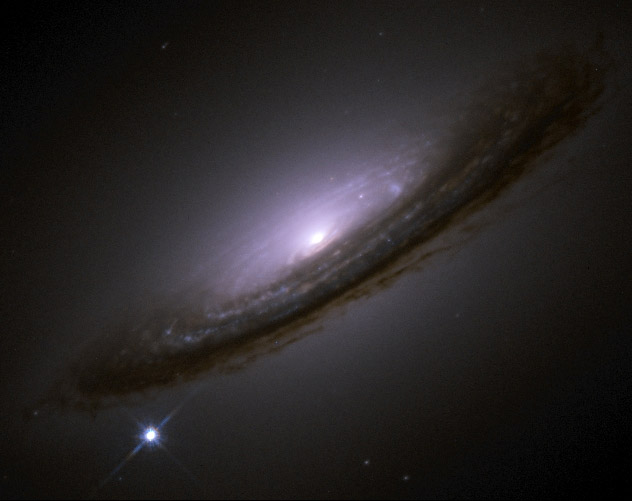
Supernova 1994D, NGC 4526 from Hubble Gallery
By this time, many neutrons have been created by the combination of electrons and protons and some of them react with the Fe to create heavier, radioactive elements which subsequently are expelled into the supernova. These radioactive elements then decay with emission of gamma rays. (It has been proposed that such gamma rays from a huge supernova may have been the cause of the Ordovician-Silurian extinction around 447-443 Mya; see the geology chapter.) Be that as it may, many of these atoms combine by simple chemical reactions and form a new, but richer, dust cloud in space, richer because it contains all those heavier elements produced by the first-generation stars. These elements include C and O which are necessary for life as we know it. This cloud may be the source for new stars. This is the third and final step in nucleosynthesis.
To resume, nucleosynthesis takes place in three steps:
The remaining core of the exploded star is reduced to a small, extraordinarily dense clump of neutrons. Such neutron stars often rotate rapidly and have strong magnetic fields. Jets of particles are expelled along the poles and appear to flash as the star spins. Such start are called pulsars.
However, if the collapsed core outweighs three solar masses, gravity is so strong that nothing can escape it, not even light. The core becomes a black hole.
Many – maybe most – stars in the universe are binary, meaning that two relatively nearby stars revolve around the center of gravity of the pair. If one of them is below the Chandrasekhar limit and so becomes a white dwarf, it may pick up matter radiated by its twin. If enough such matter is accreted to its surface, it may become massive enough, compared to the Chandrasekhar limit, that the electron degeneracy7Another name for the Exclusion Principal can no longer support it and it explodes into a Type Ia supernova (SNIa). Such objects are extraordinarily bright.8The most recently viewed one in our galaxy was observed in 1572 by the young Danish astronomer Tycho Brahe. They are important to cosmologists as they all burn with the same luminosity, making them standard “candles” which can be used to estimate their distance from the Earth (by their apparent brightness) and their speed (from the Doppler shift of their spectra, known as the red shift). In this way, astronomers have measured the speed and distance of galaxies and made an extraordinary discovery: The expansion of space has been accelerating for the last 7 billion years.
Stars are important, but there are larger and smaller structures in the universe. We live on one of them. So on to galaxies, clusters and large-scale structures.
Notes
| ↑1 | After Big Bang |
|---|---|
| ↑2 | The Jeans mass depends on temperature and density, but is typically many thousands of solar masses. |
| ↑3 | A word on notation. A superscript before an element’s symbol denotes its atomic mass, essentially the total number of neutrons plus protons in the nucleus. |
| ↑4 | If only we could harness this fusion energy here on Earth! |
| ↑5 | Most authors would say 10 billion years, but in order to be consistent with later chapters, we will say 10 Gy |
| ↑6 | Note that a planetary nebula has nothing to do with planets. |
| ↑7 | Another name for the Exclusion Principal |
| ↑8 | The most recently viewed one in our galaxy was observed in 1572 by the young Danish astronomer Tycho Brahe. |
Cosmology is the study of the origin and evolution of the cosmos, where by cosmos we mean everything – no less. This is a subject which has always fascinated mankind and has given rise to many fanciful and often farcical stories. It is one of the principle reasons for the invention of religion. We looked at one such story in the introduction, the cyclic creation, maintenance and destruction of the cosmos by Brahma, Vishnu and Shiva. Now let’s get serious.
We know from astronomical observation that the universe – space – is expanding. The stars, galaxies and other distant celestial bodies are moving away from us (and we, from them). Observation of type 1a supernovae (explained later) has shown that for the last 7 Gy the expansion has been accelerating slowly.
If we do a backwards extrapolation of the measured expansion, we find that about 14 Gya all spatial objects were in the same place. This figure has recently been refined to 13.8 Gya.1According to the WMAP project, the age of the universe is 13.77 ± 0.059 billion years. http://map.gsfc.nasa.gov/universe/uni_age.html. The ESA Planck probe finds 13.799 ± 0,021 billion years. We will settle for 13.8 Gya. The entire visible universe once occupied a very small region, smaller than the size of an atom.
It is important to understand that we can see only part of the cosmos, the visible universe, or what we call “our Universe”. It is limited in size because of the time light takes to get from a distant point to us and because of the age of the universe. Light travels with a finite speed, so the more distant an object or event, the more time light takes to reach us and the farther back in the past the event we are seeing. The most distant objects we can see are therefore the oldest, those which emitted their light at the time of the Big Bang, about 14 Gya. Because space has been expanding in the meantime, such objects are now about 46 Giga light-years away, which is thus the current radius of the visible universe.2Carroll (2010), 387n38. It is, of course, getting bigger all the time.
Astronomers, cosmologists and physicists – the folks who worry about this sort of thing — generally accept the Inflationary Big Bang as the explanation of the origin of our universe, simply because it is capable of accounting for many facts left unexplained by the original, non-inflationary Big Bang hypothesis.3Some scientists contest inflation, even hotly. See, e.g., Hossenfelder, “Is the inflationary universe a scientific theory? Not anymore.”. http://backreaction.blogspot.fr/2017/10/is-inflationary-universe-scientific.html
The inflationary Big Bang framework says that the universe has evolved in a two-step process:
In a nutshell, our universe started out smaller than the current size of an atom. It was roughly uniform but with tiny quantum-mechanical fluctuations (often referred to as “jitters”). Almost instantly, on a human time scale, it inflated (expanded) enormously to about the size of a grapefruit.4Tegmark (2014), 117. The rapid expansion isolated the quantum jitters before they could resolve. When inflation stopped, a mainly uniform space had been filled with matter formed from the spread-out quantum fluctuations. Since that time, it has expanded well beyond what we can see of it.
It must be stressed that when we speak of the expansion of space, we mean the “fabric” of space itself. The expansion is a property of space only: As space expands, the push to expand remains the same at each (new) point and does not dilute away. Only space expands and only on very large scales. On smaller scales, the other physical forces, such as gravity, keep particles and planets together. Although the space around our galaxy, the Milky Way, is expanding, the galaxy is not. Nor are the stars, nor the planets, nor you nor I.5If you are expanding, you cannot blame it on universal inflation.
One of the strong points of the inflationary Big Bang is that it explains how the expansion started. It was due to the properties of the inflaton field. Read on.
The origin of inflation is thought to be due to a field called the inflaton field (or false vacuum). This field was originally in a metastable state of high energy in which it exerted a huge outwardly-directed force which caused space to expand enormously, in fact exponentially, doubling its size every 10-37 seconds.
Such an increase in size rapidly becomes huge. At that scale, doubling its size every 10-37 seconds, one hundred doublings would have taken about 10‑35 seconds, but would have resulted in a total increase by a factor of 2100 = 1.3×1030.6Greene (2004), 308, Guth (1997), 173. Max Tegmark says the doubling may have occurred every 10‑38 seconds.
Here’s more detail. The inflaton field was in a state of unstable equilibrium. Anyone who has ever been delicately balanced, say on a taut rope, so that if she leans one way or the other she starts to fall, understands what it means to be in unstable equilibrium. At about 10-35 seconds of age7Greene (2004), 285., the field “lost its balance” and started to “fall” (metaphorically) off its high value. After about 10-32 seconds, space had “fallen” as far as it could in the inflaton field, effectively hitting “bottom”. More precisely, it reached its point of minimum energy in the inflaton field. The inflation stopped but the universe went on expanding, but more slowly, under the outwardly-directed pressure of gravity (the cosmological constant). The energy released by the “falling” inflaton field provided the energy and matter that constitute the universe today. As each bit of matter exerted a gravitational attraction on every other bit, the rate of expansion slowed down. When the universe attained the age of about 7 billion years, the expansion rate began accelerating. More on that later.
At its pre-inflation size, the universe was so small that it must be explained using quantum mechanics, according to which states of energy normally forbidden by the Law of Conservation of Energy can exist for very short periods of time, as explained in the theory chapter. So there were a great number of relatively very tiny places where the energy was higher or lower than the average. The rapid inflationary expansion caught these energy fluctuations unaware, so to speak, and scattered them out over macroscopic scales before they could merge and even out the energy. They gave rise to particles and antiparticles. This tiny non-uniformity has been observed in the cosmic microwave background radiation (explained shortly).
The inflationary Big Bang solves the so-called horizon problem: How the universe managed to reach large-scale uniformity without there having been enough time for light to traverse it. Before the inflaton field started “falling”, the universe was so tiny that light could travel from any part to any other, so it managed to reach a state of internal equilibrium in which it was all at practically the same temperature everywhere. As the universe inflated, this region of almost constant temperature did too, so the universe we see today is approximately homogeneous, at least on a large scale, a fact which is confirmed by satellite observation.8NASA WMAP project, http://map.gsfc.nasa.gov/universe/bb_cosmo_fluct.html. These results have been refined by the more recent Planck probe.
Inflation also resolves the so-called flatness problem, since it was so fast that the resulting universe looks flat. (Think of the surface of a balloon which is rapidly inflated to a very large size.9Better yet, glue some 2-centime pieces to the balloon, before you inflate it more. You will see how the coins move apart without getting any larger.) In cosmology, flatness is very important, as it means the expansion will continue; otherwise, the universe would begin to collapse back together, terminating in a “Big Crunch”.10The flatness problem is more complex than this says, but it gives the idea. (More on flatness late, too.)
There are several reasons to think inflationary exponential expansion took place. It explains why expansion took place (the inflaton field), as well as why space has a uniform temperature everywhere on the average. And it shows how perfectly “normal” quantum-mechanical phenomena (briefly-existing spots of non-conserved energy) gave rise to packets of energy and eventually particles.
This much is agreed on by almost all versions of the inflationary Big Bang theory, but there are several versions of it — far too many, according to critics.
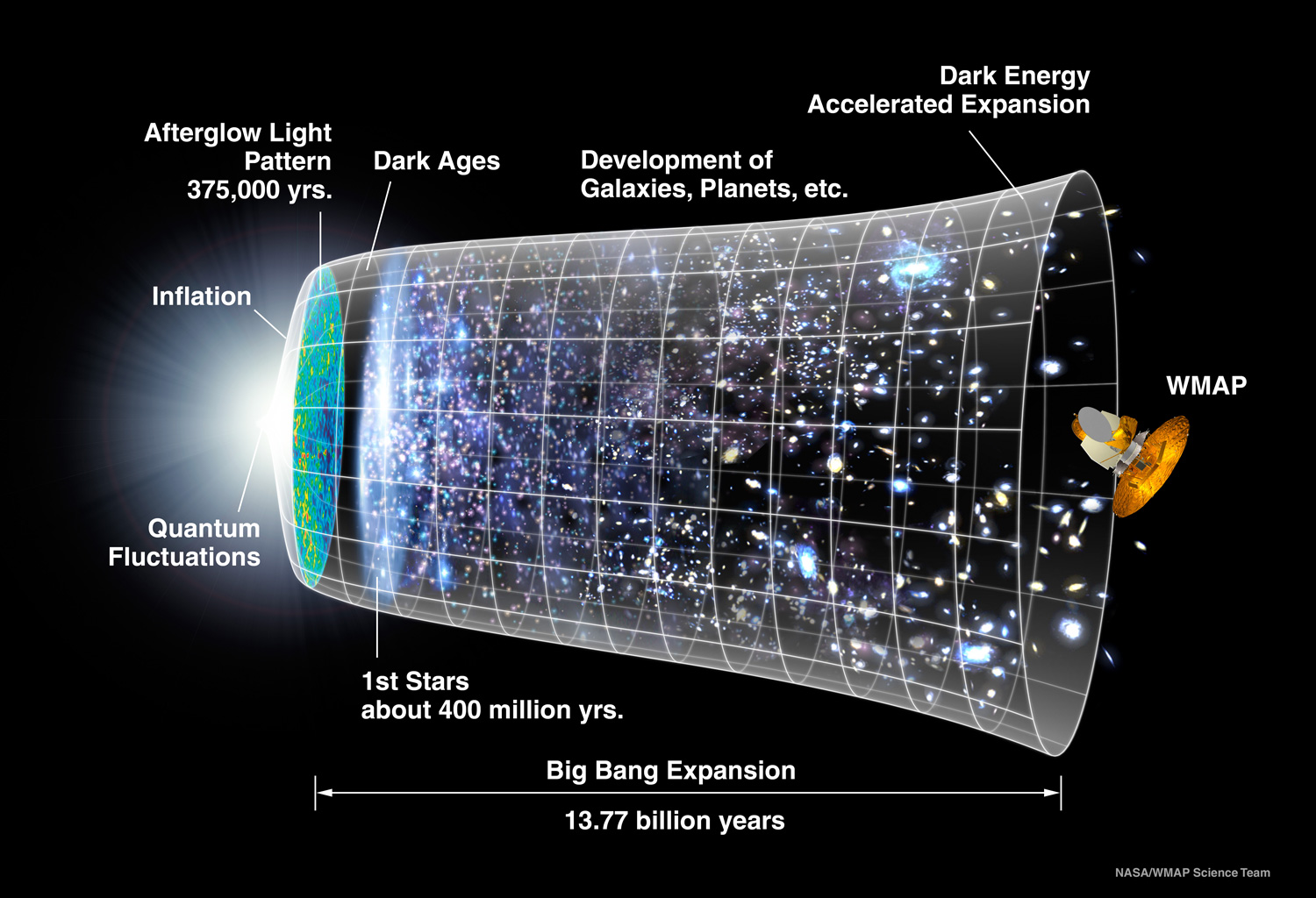
Time line of the inflationary Big Bang, from WMAP via NASA
No one knows if the universe is infinite. Period.
There are many versions of inflation. In some models, expansion goes on forever. In small, local regions, the inflaton field may decay non-uniformly into “bubbles” (like boiling water). Each bubble may fall off its metastable energy peak to give up energy to form … a universe! Each one looks like ours to the extent that it has been born out of an inflationary burst, but the physics may vary from one to another. (This process has been compared to cell divisio11Guth (1997), 251., but does this suggest that the inflationary multiverse should be regarded as an evolutionarily evolving population of universes? I think not.)
Such universes within the inflationary multiverse have been called “pocket” or “bubble” universes. Each one is infinite. Although the pocket may seem finite from the outside, time is transformed into space inside due to the effects of relativity, making the interior infinite!
Since inflation continues forever in this scenario, the Big Bang at the origin of our universe was really the moment when inflation in our part of the multiverse stopped.
This multiverse hypothesis is a suggestion on the extreme edge of cosmology, but it is taken seriously by many cosmologists. In fact, there are other multiverses proposed. For more info, see the multiverse page.
Once the inflaton field’s energy was spent, inflationary expansion ended. The universe went on growing under the pressure of the cosmological constant, but the gravitational attraction of all that mass limited the expansion. As the universe expanded, it cooled.12Think of how a bicycle tire gets hot as you pump air into it; this is just the opposite phenomenon. All temperatures from Guth (1997), 86-94. It was then that the first step in the formation of chemical elements began.
| Time after Big Bang | Temperature of universe13All temperatures from Guth (1997), 86-94. |
| 10‑39 secs | 1020K |
| 1 sec | 1010K |
| 7 days | 17×106K |
| 1 year | 2×106K |
| 100 Kyrs | 5.8×103K |
Big-Bang nucleosynthesis, the formation of the light chemical elements, hydrogen, helium and lithium, took place in the period from about 1 sec (or less) to 3-4 minutes after the Big Bang. Hee’s how.
At .1 sec ABB, it was too hot for atomic nuclei to form. The universe was filled with rapidly moving protons and neutrons, electrons and positrons, neutrinos and antineutrinos and lots of radiation (photons). Protons and neutrons constantly changed into one another.14The ratio of protons to neutrons was 1.61, due to the equilibrium rate of the reactions.
Remember the four basic forces of physics? At such high temperatures, their impact was negligible. But as temperatures fell and particles moved more slowly, the strong force was able to exert its influence – by forming nuclei (but not yet atoms).
At around one second of age15Guth (1997), 94., the universe’s temperature was “cool” enough that the frenetic activity of all those particles calmed some. Protons stopped changing into neutrons, but neutrons still decayed into protons and electrons.16Since neutrons are slightly heavier than protons. Neutons which did not decay combined to make an isotope of hydrogen called deuterium (2H, one proton + one neutron). Electrons and positrons annihilated to form huge amounts of photons, visible today as the Cosmic Microwave Background radiation. By 30 seconds of age, about half the electrons and positrons had mutually annihilated.
At about 3 minutes of age, the universe became an element-producing nuclear furnace. Deuterium nuclei combined to form helium (4He). In this way, the lighter elements, including small amounts of lithium (3Li), were formed. This was the era of Big-Bang nucleosynthesis, the first of three steps in the formation of the elements of the universe. At the end of this period, there were seven protons for every neutron. Free neutrons mostly combine with protons to make 4He, so the Universe was composed of 75% protons and 25% 4He by mass and still is today, give or take a small amount of trace elements.17Take 14 protons and 2 neutrons, make as much He as possible, and you get 12 protons (total atomic mass ~12) and one He (atomic mass ~4), which gives the 75:25 ratio.
As the universe continued expanding and cooling, more heat was given off in the form of radiation, i.e., photons. The photons had such high energy that they continually knocked electrons loose from any protons they might bond with, keeping all the atoms ionized. So the matter was in the form of a plasma, a “soup” of rapidly-moving free protons, neutrons and electrons. Just as the photons released electrons from atoms, so the electrons scattered the photons, which were thus like light in a cloud or fog. In a word, the universe was opaque.
After about 380,000 years, the temperature of the universe descended to around 3000 Kelvin, and the electromagnetic force bound electrons with nuclei to form atoms, a process called recombination by cosmologists. The binding of electrons in atoms was equivalent to a phase change (like, say, water freezing to ice) and is considered as such by physicists. Photons now were no longer deflected by electrons and the universe became transparent, although the number of photons was so low that it was still dark and there were not yet any stars to make more light. The photon radiation was emitted in all directions and is still “visible” today.18Since it is in the microwave frequency, we cannot really see it. This Cosmic Microwave Background Radiation (CMB) is light from 13.3 Gya.
When we look up into the sky, we are looking into the past, because of the time light from distant celestial objects takes to reach us. But because the universe was opaque until 380 Ky ABB, we can see no farther back than that. The most distant light we can detect is composed of the remnants of radiation emitted then, now reduced now reduced by the expansion of space to microwave frequencies.
Here’s a nit: Recombination took place over a short period of time. Shortly after its beginning but before it finished, enough electrons were bound that photons could begin to move about without scattering. So this latter event, called decoupling of photons, took place a little after recombination.
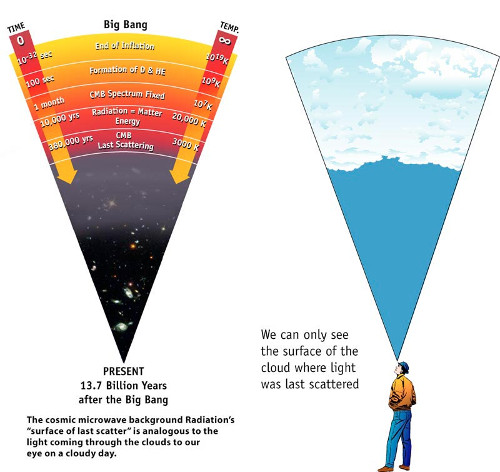
Just as we cannot see past the surface of a cloud, we cannot see past the time when the universe became translucid. From NASA
The great uniformity in the distribution of this radiation lends support to the cosmological principle, the idea that the universe is uniform or homogeneous on very large scales, on the order of 106 light-years.
After about 200My, something happened to dispel the darkness. To find out what, read about the life of stars.
Notes
| ↑1 | According to the WMAP project, the age of the universe is 13.77 ± 0.059 billion years. http://map.gsfc.nasa.gov/universe/uni_age.html. The ESA Planck probe finds 13.799 ± 0,021 billion years. We will settle for 13.8 Gya. |
|---|---|
| ↑2 | Carroll (2010), 387n38. |
| ↑3 | Some scientists contest inflation, even hotly. See, e.g., Hossenfelder, “Is the inflationary universe a scientific theory? Not anymore.”. http://backreaction.blogspot.fr/2017/10/is-inflationary-universe-scientific.html |
| ↑4 | Tegmark (2014), 117. |
| ↑5 | If you are expanding, you cannot blame it on universal inflation. |
| ↑6 | Greene (2004), 308, Guth (1997), 173. Max Tegmark says the doubling may have occurred every 10‑38 seconds. |
| ↑7 | Greene (2004), 285. |
| ↑8 | NASA WMAP project, http://map.gsfc.nasa.gov/universe/bb_cosmo_fluct.html. These results have been refined by the more recent Planck probe. |
| ↑9 | Better yet, glue some 2-centime pieces to the balloon, before you inflate it more. You will see how the coins move apart without getting any larger. |
| ↑10 | The flatness problem is more complex than this says, but it gives the idea. |
| ↑11 | Guth (1997), 251. |
| ↑12 | Think of how a bicycle tire gets hot as you pump air into it; this is just the opposite phenomenon. All temperatures from Guth (1997), 86-94. |
| ↑13 | All temperatures from Guth (1997), 86-94. |
| ↑14 | The ratio of protons to neutrons was 1.61, due to the equilibrium rate of the reactions. |
| ↑15 | Guth (1997), 94. |
| ↑16 | Since neutrons are slightly heavier than protons. |
| ↑17 | Take 14 protons and 2 neutrons, make as much He as possible, and you get 12 protons (total atomic mass ~12) and one He (atomic mass ~4), which gives the 75:25 ratio. |
| ↑18 | Since it is in the microwave frequency, we cannot really see it. |
Actually, it should be “What cosmology and astronomy and astrophysics tell us”, but that would have been too long. This is the history of the universe, from almost 15 billion years ago until tomorrow.
We start with the beginning — the Big Bang.
Then on to the life of stars
Then galaxies, clusters and large-scale structures.
Then on to a new domain of study — geology.
